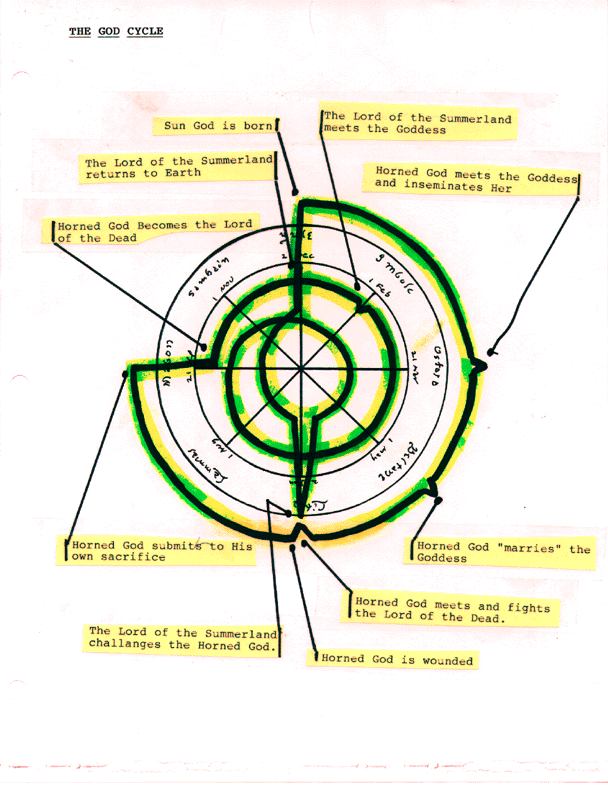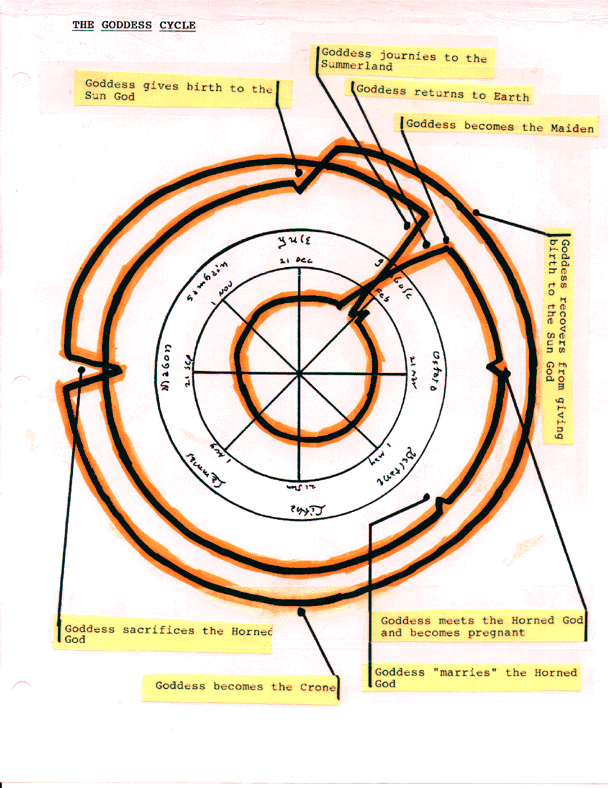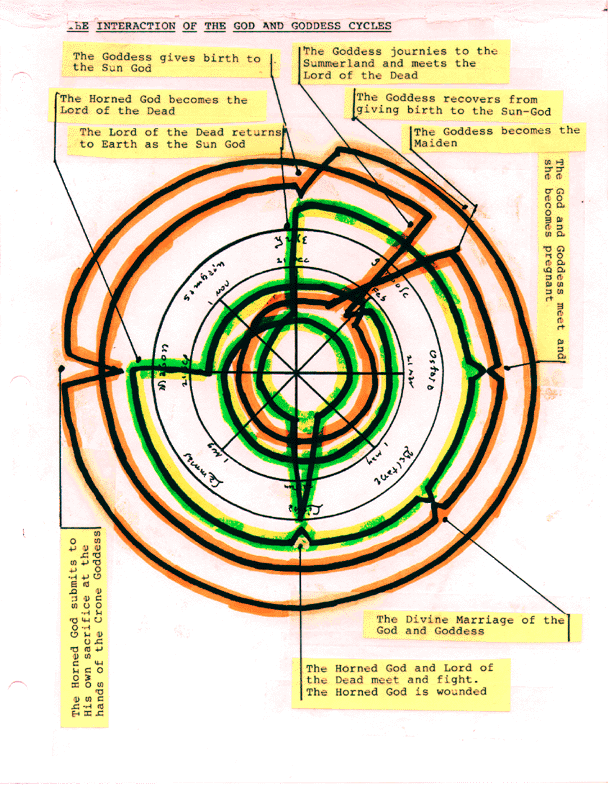
The Gods and the Wheel of the Year
by Rick Johnson
Disclaimer: The following article is not Gardnerian but it does incorporate aspect from a number of British Traditional views. It is simply my attempt to make some sense of this religion that we all love.
The Wheel of the year with the sequence of the eight Sabbats is a constant among Witches regardless if they celebrate the Four Greater Sabbats or the Six or the modern Eight. We are all taught the basic meanings which are, with some variations in name and function:
Samhain is New Years Eve and the time to honor the dead and when the Horned God becomes the Lord of the Summerland and the changeover from Summer to Winter and the change from the Goddess to the God.
Yule is mid-winter, the rebirth of the God as the New Sun-God and the fight between the Oak King and Holly King.
Imbolc is the recovery of the Goddess after giving birth to the God and the promise of a new Spring.
Ostara is the ripeness of Spring and the time when the Goddess becomes pregnant by the Horned God.
Beltane is the beginning of Spring, the change over from Winter to Summer, the Divine Marriage and the New Year and represents the change-over from God the Goddess.
Litha is mid-Summer, the weakening of the Sun-God after His battle with the Darkness.
Lammas is the First Harvest and the death of the Horned God.
And Mabon is Autumn and the final harvest and the sacrificial death of the Horned God.
And when you look at the actual Wheel of the year, you see a number of things as if there were three cycles hidden within: The Seasonal Cycle, and the Mythic Cycle that is composed of the God Cycle and the Goddess Cycle.
The Season Cycle is: Spring starts at Imbolc and peaks at Ostara. Summer starts at Beltane, and peaks at Litha. Autumn starts at Lammas and peaks at Mabon. And Winter starts at Samhain and peaks at Yule to start all over again.
We relate this to ourselves as imbolc as a time for hope, Ostara and Beltane for love, Litha to remember the Three-Fold Law and how it relates to us, Lammas as a celebration of what we have earned, Mabon as anothercelebration of our rewards and the sacrifices we make, Samhain as a time of introspection and Yule as a time for new beginnings.
Then when you look at the Wheel and the Horned God at the same time, you see something interesting:
The God dies at Mabon to become Lord of the Dead at Samhain when He rules for 6 weeks until Yule when He is reborn as the Sun-God. Then at Ostara He gets the Goddess Pregnant and marries Her at Beltane. Then at Litha, somehow He faces His darker self and is wounded and weakens like the Sun until He dies at Lammas or at Mabon to repeat the Cycle.
And when you look at the Wheel and the Goddess at the same time, you see other interesting things:
The Goddess is a young Maiden at Imbolc when She recovers from giving birth to the God. Then at Ostara She gets pregnant and marries at Beltane. She then ages to become the Crone until She gives birth at Yule and become the Mother for six weeks until She becomes the Maiden again at
Imbolc.
I see some contradictions and conflicts here. In fact, one of my earliest Initiates, Sue, got upset in 1982 and said "I want my religion to make sense!" I replied that the Craft is deliberately contradictory to prevent fundamentalism. But then, as I thought about it, I realized that I was wrong. Witchcraft, like any religion, doesn't have to be logical but it must be poetic. It must strike my soul and enlighten my being and somehow, some of these contradictions rub my soul the wrong way.
I can accept that the Cerne Giant has had a 30 foot erection for over 2000 years. And I can accept the idea of the Goddess being the Maiden, Mother and Crone all in one. But somehow, there are things that not only don't enhance my soul, but their very existence causes problems of acceptance with others. I need to find some way to come to terms with these conflicts these so that my soul can be at rest and flow with the divine consciousness.
What about this thing where the Goddess is Maiden from Imbolc to Lammas when she becomes the Crone and the Crone gives birth to the God? The Crone becomes the Mother? The Mother is here for only six weeks until She becomes the Maiden again? And The God is Lord of the Summerland for only 3 months from Mabon to Yule? When does the Goddess go to the Summerland to give birth to the new souls? And just where does the God find that 'person' He fights with at Litha (or Yule)?
I need these questions answered.
So, after a lot of thought and some inspiration, the answer occurred to me. The Gods don't exist in one yearly cycle that is repeated endlessly, They live Their own cycle over a number of years taking on different roles at different
times..

The Sun God is born at Yule by the Great Mother Goddess and bonfires are built to strengthen Him. He ages until at Ostara He meets the Maiden Goddess and They court each other. At Ostara, She becomes pregnant and by Beltane Her condition is apparent so They marry and He becomes the Horned God. At Litha, another, darker God appears on the scene to challenge the young Horned God to battle for the world. They fight and the challenger is defeated and driven off, but not before the Horned God is wounded in his genitals. He lives but weakens, and with him, so does the world, and so bonfires are set to give Him healing energy and strength. But by Mabon, His wounds are so great that He finally must die.
In order that the world may live, He offers Himself at Mabon as a sacrifice to His Mother, who has aged into the Crone and She takes this willing sacrifice and cuts Her Son down as His Maiden bride, pregnant with His seed, mourns . The Horned God dies and enters the Summerland where he reigns, lonely and alone and this loneliness makes Him stern.
Then the Goddess appears, older but growing younger with each step into the Summerland. She seeks knowledge and wisdom and Her dead consort but finds the Lord of the Dead instead. They love and are one for a year in the Summerland, caring for the souls of the dead until the Goddess feels the tug of life. She leaves Him and He is, once again, alone.
By Litha, He makes His decision, He must return to the world of the living. So He returns at Litha to find His younger self firmly entrenched in life. Knowing the future, He knows that if He, as a young God, remains, there will be no one to care for the souls of the dead. The decision is hard but must be done. So the Lord of the Dead challenges the Young Horned God, knowing that He challenges Himself. They fight and the Lord of the Death must triumph, but at the same time must not win. He manages to wound the young Horned God before He is driven back to the Summerland.
He returns, content in what must be. He waits and months later he feels the tug of life and he is drawn to the Womb of His former Bride where He is born again, a new baby Sun-God and the cycle
repeats.

The Goddess, a Maiden at Imbolc brings to the Earth new life and She rejoices as She sees the young Sun-God and is smitten. They court each other and She gives Herself to Him at Ostara becoming pregnant in the act. By Beltane, They know that She is with child and they marry as He becomes the Horned God.
But Her joy is short lived for at Litha Her consort is challenged by a Dark Stranger. With strength and courage Her Consort defeats the challenger but is wounded in the process. She can keep Him alive but not forever and by Mabon it is clear that Her Consort can no longer support His duties.
So at Mabon, They journey to His mother The Crone and He makes the decision. It is Him or the world and so He gives Himself as a sacrifice to His mother that the world may live. The Maiden mourns but is comforted by the growing life within Herself and three months later, in the middle of Winter, the time when there is no hope and all is dead, She gives birth at Yule to the New Sun God.
Bonfires are lit to give the newly-born Sun-God strength in this critical time and the Maiden finally becomes the Mother. For six weeks She tends Her child and by Imbolc She is fully recovered and Her child becomes a youthful God. She sees Her Son meet a young Goddess. She watches Her Son court and consummate and marry this Goddess and she takes joy in Their lives as She once took joy in her own.
But at Litha, She sees a Dark Lord challenge Her Son and She can do nothing but watch the battle for She knows what is to happen. Her Son triumphs but is wounded and weakens. History repeats itself and at Mabon, she prepares Herself. She is ageing into the Crone and Her wisdom sees the world die with Her Son. Her Son, heavy with responsibility, approaches Her. With a heavy heart, She accepts His willing sacrifice and kills Her own Son.
The Crone Mourns and with Her Son gone, She has no desire to keep the world alive and the Winters come. She wonders the world, empty. Before, when She lost Her Consort, She had, at least, the comfort of their child to ease the ache within. Now, with no consort and no child, She wanders the world remaining only for the birth of Her grandchild.
When He is born, She takes comfort but there are questions to ask. Why did She lose both Her Consort and Her Son? Why both in the same way? So She journeys to the Summerland to seek the answers to these questions. As She enters the tunnel, She gives up the trappings of the material world and becomes younger as She does so.
Eventually, She meets the Lord of the Dead and questions Him as to why He took Her Consort and Son. He answers and She finds Herself attracted to this Dark Lord. They love and She remains to give birth to the souls that He has been caring for.
By Litha, She watches The Lord of the Dead return to the Earth to challenge His younger Self that what must be will be. Now that She has solved all mysteries. She knows what will happen and why. All Her questions have been answered but one. Her Consort, the Lord of the Dead, the Horned God, the Son-God all in one returns and They love again.
At Mabon, They retire as He who Her Lord wounded, enters the Summerland to take over as the new Lord of the Dead. She watches Her Lord grow young and finally be drawn back to the Earth to be reborn- once again.
She is comforted by the knowledge that all things are progressing as they must ... but there is one thing left to do. The Goddess journeys back to the earth, growing young once again until She arrives at Imbolc as the Maiden to meet her Love
again.

SYMBOLS OF THE CYCLE
Ritual is our way of relating to the Divine. One way we do so is to perform a divine play that allows us to partake in the lives of the Gods in a manner that can only be described as poetic. For poetry is the language of the inner mind and of the Gods themselves.
As poetry is written in symbolic form, all that we do within a Ritual should have a symbolic meaning as well. Here are a few symbols and their meanings.
Yule is the shortest day of the year. After this, the Sun rises earlier and sets later each day. It is only a short jump to seeing that as the Sun-God grows, so do the days. Bonfires represent the Sun and so they are jumped as a magickal spell to give strength to the Sun. Some Traditions have a combat between the Holly King and the Oak King to symbolize the change of winter and the conflict between the waning and waxing of the Solar year.
Imbolc means "in the belly' and refers to life, still within the earth (the Goddess) but ready to burst forth. Imbolc is the time when you notice that even though it is still cold, the sun is rising noticibly earlier each day. in other words, hope for the new year. Bonfires are jumped for purification. Also this is when the Goddess recovers from giving birth at Yule.
Ostara comes from the Goddess Eostre who represent the Spring. After being cooped up all winter, it's party time. Love chases and sexual frolicing are common.
Beltane refers to the bonfores that are burned on that day. Unlike the Yule fires that are jumped to strengthen the new-born Sun-God, Beltane fires are jumped for luck and purification. The Maypole was moved from Ostara to this day as an obvious phallic and sexual symbol.
Litha is the Summer Solstice. This is the longest day of the year and from this day on, the days grow shorter. Thus it is a short leap to the symbol of the Sun-God being wounded and slowly dying. Bonfires are jumped here as a spell to give strength to the God.
Lammas and Mabon share two of the same symbols. They are both harvest festivals and the Horned God dies on reither day, depending on the Tradition. With Lammas, however, athletic games were played as opposed to the sexual games of Ostara.
Mabon is the Final Harvest and the Full Moon closest to the Autumn Equinox was often called the Harvest Moon. In some Rites, the HPS uses a crescent sickle to cut a sheaf of wheat held by the HP to symbolise the castration and death of the horned God.
Samhain is the New Year's Eve when the old year ended at sunset of Samhaim Eve and the new year began at sunrise. Therefore the time between was outside of time and the beloved dead could return to walk the earth and celebrate with their loved ones once more. Traditional Witches consider this also to be the chang-over from Goddss to God rule of the year.
The Litha/Yule combat has always bothered me. The pat answer from those who do it has always been along the lines of the Horned God's Darker Side but there was never an explanation as to why or how He arrived? When pushed, the response was to meditate and seek the answer for myself. Well, now here is the answer I came up with. It is the Horned God as the lord of the Sumerland making certain that His destiny will proceed according to the needs of the universe.
After the Horned God dies, He becomes the Consoler, the Lord of the Dead, the Grim Reaper. But if He dies at Lammas or Mabon and is re-born at Yule, what about the rest of the year? And where does the Horned God's attacker come in. The obvious solution was that the Horned God completes at least one full year in the Summerland. This allows Him to return at Litha for the challange and to meet the Goddess when She travels to the Summerland.
The Horned God is then re-born as the Sun-God at Yule again.
The Goddess is Maiden, Mother and Crone. She is the Maiden in the Spring, Mother in the Summer and Crone in the Winter ... "when she gives birth?" This has always bothered me so I allowed Her to remain a Maiden until the God was born. Then She could have a season as the Mother before ageing to the Crone.
Also, if the Goddess is the Mother of all Living and we are all reincarnated, She needs to have some way to take the souls of the dead from the Summerland so that they may be re-born themselves. As we know She visited the Summerland, it made sense for Her to remain for a year to take care of her 'classified' duties as well as arraing for the rebirthing of the souls.
The Maiden Aspect is also called the Virgin, not because She is 'virgo intacta' but because She is free and not 'owned' by any man. The Maiden was always sexually active as was the Horned God. In the old days, women often wouldn't marry until they were pregnant to show that they were fertile and their intended was virile.
You will notice that the Horned God dies and is reborn but the Goddess never dies. She may visit the Summerland but does so without death.
When the Crone sacrifices the Horned God at Mabon (or Lammas), she uses a sickle which is shaped as a crescent (waning) moon.
This, then, is my myth of the Wheel of the Year and why I have written it.